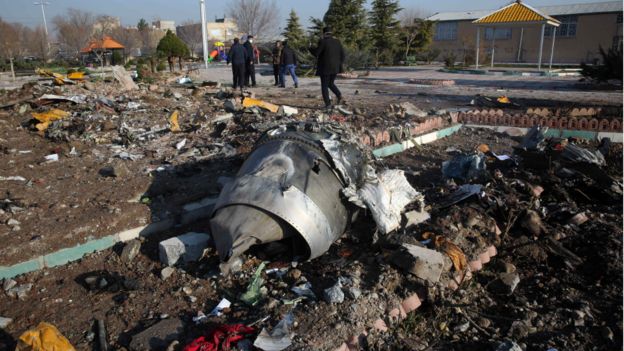Evidence suggests an Iranian missile brought down a Ukrainian passenger plane that crashed near Tehran, possibly in error, Western leaders say.
The leaders of Canada and the UK called for a full and thorough investigation into the crash, which killed all 176 people on board.
Iran has ruled out a missile strike by its air defences.
The crash came just hours after Iran carried out missile strikes on two airbases housing US forces in Iraq.
US media have speculated that the timing of the crash suggests the plane may have been mistaken for a US warplane as Iran prepared for possible US retaliation for the strikes.
CBS News quoted US intelligence sources as saying a satellite detected infrared “blips” of two missile launches, followed by another blip of an explosion.
Meanwhile, Newsweek quoted a Pentagon and senior US intelligence officials, as well as an Iraqi intelligence official, as saying they believed Ukraine International Airlines flight PS752 was hit by a Russian-made Tor missile.
US President Donald Trump said on Thursday that he had “suspicions” about what happened to the plane.
Amid tensions heightened by the US killing of top Iranian general Qasem Soleimani on 3 January, Iran has said it will not hand over the recovered black box flight recorders to Boeing, the plane’s manufacturer, or to the US.
Under global aviation rules Iran has the right to lead the investigation, but manufacturers are typically involved.
What is being said about the possible missile strike?
Canadian Prime Minister Justin Trudeau said he had received intelligence from multiple sources indicating that the plane was shot down by an Iranian surface-to air missile, adding that it was possible that this was unintentional.
“This reinforces the need for a thorough investigation,” he said. “Canadians have questions and they deserve answers.”
But he said it was too early to apportion blame or draw any conclusions, and he refused to go into detail about the evidence.
A total of 63 Canadians were on the flight, along with dozens of others who were expecting to fly on to Toronto from Kyiv.
UK Prime Minister Boris Johnson echoed Mr Trudeau’s words and said Britain was working closely with Canada and other international partners affected by the crash.
Meanwhile, Newsweek quoted US and Iraqi officials as saying they believed the aircraft was hit by a Russia-built Tor M-1 surface-to-air missile system.
Two Pentagon officials had assessed that the incident was accidental, Newsweek added.
It quoted sources as saying that Iran’s anti-aircraft systems were probably active following its attacks on the US airbases.
The Pentagon has so far made no public comment on the issue.
Meanwhile, when asked what he thought had happened to the plane, President Trump answered: “I have my suspicions. It’s a tragic thing when I see that, it’s a tragic thing. But somebody could have made a mistake on the other side.
Earlier on Thursday, Oleksiy Danylov, the secretary of Ukraine’s security and defence council, said in a Facebook post (in Ukrainian) that three other possible crash causes were being considered:
- a mid-air collision with a drone or other flying object
- engine destruction/explosion due to technical reasons
- an explosion inside the plane as a result of a terror attack
Mr Danylov said Ukrainian investigators, who are already in Iran, wanted to search for possible debris from a missile at the site of the crash. Iran is known to have Russian missile defence systems.
The investigation would include experts who worked on the investigation into the 2014 downing of Malaysia Airlines flight MH17 in eastern Ukraine, Mr Danylov added.
What does Iran say?
Iran’s Civil Aviation Organisation (CAOI) chief Ali Abedzadeh said: “The plane, which was initially headed west to leave the airport zone, turned right following a problem and was headed back to the airport at the moment of the crash.”
Mr Abedzadeh added that witnesses saw the plane “on fire” before the crash, and that pilots had not made any distress calls before trying to return to Imam Khomeini airport.
“Scientifically, it is impossible that a missile hit the Ukrainian plane, and such rumours are illogical,” he said.
“Several domestic and foreign flights were flying in Iranian space at the same altitude of 8,000ft (2,400m). The issue of the missile’s impact on the aircraft cannot be true in any way,” he said.
Mr Abedzadeh said the initial findings had been sent to Ukraine and the US, where Boeing has its headquarters.
Sweden and Canada had also been sent the findings, as their nationals were on board, he added.



















































